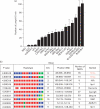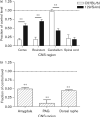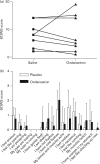From mouse to man: the 5-HT3 receptor modulates physical dependence on opioid narcotics
- PMID: 19214139
- PMCID: PMC2730361
- DOI: 10.1097/FPC.0b013e328322e73d
From mouse to man: the 5-HT3 receptor modulates physical dependence on opioid narcotics
Abstract
Objectives: Addiction to opioid narcotics represents a major public health challenge. Animal models of one component of addiction, physical dependence, show this trait to be highly heritable. The analysis of opioid dependence using contemporary in-silico techniques offers an approach to discover novel treatments for dependence and addiction.
Methods: In these experiments, opioid withdrawal behavior in 18 inbred strains of mice was assessed. Mice were treated for 4 days with escalating doses of morphine before the administration of naloxone allowing the quantification of opioid dependence. After haplotypic analysis, experiments were designed to evaluate the top gene candidate as a modulator of physical dependence. Behavioral studies as well as measurements of gene expression on the mRNA and protein levels were completed. Finally, a human model of opioid dependence was used to quantify the effects of the 5-HT3 antagonist ondansetron on signs and symptoms of withdrawal.
Results: The Htr3a gene corresponding to the 5-HT3 receptor emerged as the leading candidate. Pharmacological studies using the selective 5-HT3 antagonist ondansetron supported the link in mice. Morphine strongly regulated the expression of the Htr3a gene in various central nervous system regions including the amygdala, dorsal raphe, and periaqueductal gray nuclei, which have been linked to opioid dependence in previous studies. Using an acute morphine administration model, the role of 5-HT3 in controlling the objective signs of withdrawal in humans was confirmed.
Conclusion: These studies show the power of in-silico genetic mapping, and reveal a novel target for treating an important component of opioid addiction.
Figures










References
-
- Results from the 2006 National Survey on Drug Use and Health: National Findings Substance Abuse and Mental Health Services Administration. Department of Health and Human Services. 2006
-
- Birnbaum HG, White AG, Reynolds JL, Greenberg PE, Zhang M, Vallow S, et al. Estimated costs of prescription opioid analgesic abuse in the United States in 2001: a societal perspective. Clin J Pain. 2006;22:667–676. - PubMed
-
- Gruber SA, Silveri MM, Yurgelun-Todd DA. Neuropsychological consequences of opiate use. Neuropsychol Rev. 2007;17:299–315. - PubMed
-
- Manchikanti L. Prescription drug abuse: what is being done to address this new drug epidemic? Testimony before the Subcommittee on Criminal Justice, Drug Policy and Human Resources. Pain Physician. 2006;9:287–321. - PubMed
-
- Handelsman L, Cochrane KJ, Aronson MJ, Ness R, Rubinstein KJ, Kanof PD. Two new rating scales for opiate withdrawal. Am J Drug Alcohol Abuse. 1987;13:293–308. - PubMed
Publication types
MeSH terms
Substances
Grants and funding
LinkOut - more resources
Full Text Sources
Other Literature Sources
Medical

